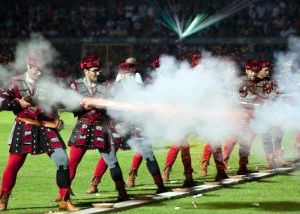
|
||||||||||||||||||||||||||||||||||||||||||||||||
|
||||||||||||||||||||||||||||||||||||||||||||||||
|
|
Cava de Tirreni
Cava de 'Tirreni is an ancient and historic city in the province of Salerno, It was also inhabited by the Lombards, whose civilization is still witnessed by a number of ancient towers built for the Game of the Doves and many place names, dating from three centuries of Lombard domination (IX-XI). The hamlet lies among the hills close to the Tyrrhenian Sea, 5 km north of the Amalfi Coast and serving in practice as its northern gateway.
The inhabited area is 198 m above sea level, in a valley situated between two mountain groups: the Lattari Mountains (which separate Cava from the Amalfi Coast) to the west and the Picentini Mountains to the east. Many of Cava's citizens reside in the hills surrounding the town.
The town is a link between the geographical area of Agro Nocerino Sarnese (flat, with an agricultural and industrial economy) and the Sorrento Peninsula (mountainous, with an economy based on tourism). The valley was certainly inhabited during the Roman Age: the discovery of several archeological relics dating back to that period stands as evidence. Remains of temples and villas of the Roman period, probably belonging to Gens Mitilia were found in the ancient villages of Vetranto and S. Cesareo. Other Roman remains were found in different parts of the territory, especially in the north, on the border of the 'Roman settlement of Nuceria Alfaterna.
Cava became a prosperous town thanks to the commercial acuity and industry of its inhabitants, who excelled in weaving and in building. Architects and engineers from Cava worked on the main public and private projects in Southern Italy. Gradually, the centre of the town moved from Corpo di Cava, the walled town close to the abbey, to Borgo Scacciaventi, known in dialect as lo commerzio (the commercial area). The pillars that can still be seen there date back to the early 15th century and are called portici (porticoes). They are still considered the centre of Cava de' Tirreni. Nearby hamlets (Italian: frazioni) of Cava are: Alessia, Annunziata, Arcara, Castagneto, Corpo di Cava, Croce, Dupino, Li Curti, Maddalena, Marini, Passiano, Petrellosa, Pianesi, Pregiato, Rotolo, San Cesareo, San Giuseppe al Pennino, San Giuseppe al Pozzo, San Lorenzo, San Martino, San Nicola, San Pietro a Siepi, Santa Lucia, Santa Maria del Rovo, Sant'Anna, Sant'Arcangelo, Santi Quaranta and Vetranto.
King Ferdinand of Aragon, who ruled over the territories of Naples, was ambushed and surrounded by the Angevins at Foce near Sarno in 1460. He was saved by the intervention of soldiers from Cava, both salaried and conscripted. Led by the Longo brothers they came to the area of Foce di Sarno, descended from the mountain and attacked the Angevins. The Angevin army, surprised and unable to determine the extent of the attack, was forced to retire, allowing King Ferdinand to flee to Naples via Nola. Grateful for their courage and for the good turn, the King sent mayor Onofrio Scannapieco a blank parchment, on which the city could write any kind of request. The Cavesi declined to make any request, and the King then conferred upon the whole city the title of Fedelissima (most loyal). The document is still conserved in the Town Hall, blank as it was in 1460. Every year since then, on the first Sunday of July, about 1000 people in the costume of the period parade through the city in the Disfida dei Trombonieri (Challenge of the Trombonists), to the rhythms and music belonging to each district, thus re-invoking this page of their history..
The Campania Region | The Provinces : Avellino | Benevento | Caserta | Napoli | Salerno | The islands | Amalfi Coast | Hamlets | Nusco | Cusano Mutri | Atrani | Castelabate | Furore |
|

|
||||||||||||||||||||||||||||||||||||||||||||||
|
||||||||||||||||||||||||||||||||||||||||||||||||
 10 km northwest of the capital and a popular tourist resort.
10 km northwest of the capital and a popular tourist resort. 

 Yearly event
Yearly event

